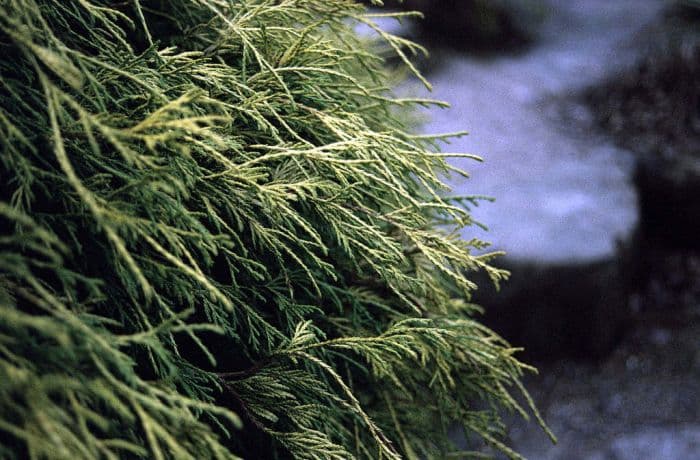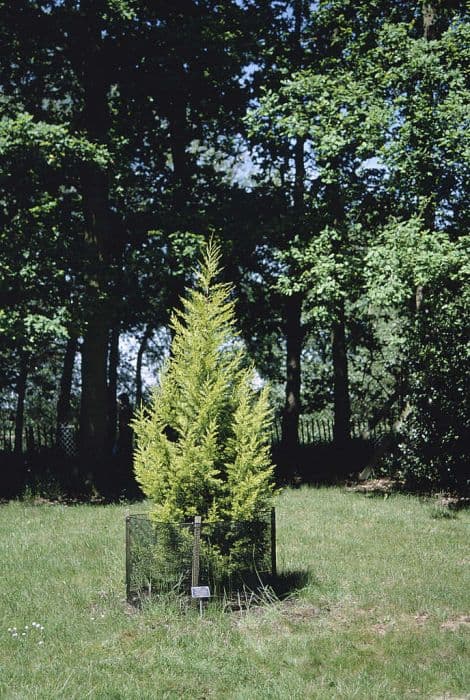Golden Mop Cypress Chamaecyparis pisifera 'Golden Mop'

ABOUT
The Golden Mop is a distinctive dwarf evergreen shrub with a unique and eye-catching appearance. It is characterized by its dense, fine foliage which drapes down from the branches, creating a mop-like effect that is highlighted by its bright golden-yellow color. The leaves are delicate and thread-like, covering the branches in a spray that sways gently in the breeze, giving the plant a soft, feathery texture. The color of the foliage tends to be more intense during the warmer months and can take on a more muted hue in cooler conditions. The shrub has an irregular, mounding growth habit, which contributes to its whimsical and somewhat disheveled look, making it an excellent choice for adding a splash of year-round color and texture to landscapes.
About this plant
 Names
NamesFamily
Cupressaceae.
Synonyms
Japanese False Cypress, Golden Mop False Cypress, Gold Thread False Cypress, Golden Mop Cypress, Golden Mop Sawara Cypress.
Common names
Chamaecyparis pisifera 'Filifera Aurea', Retinispora pisifera 'Golden Mop', Chamaecyparis pisifera 'Filifera Aurea Nana'.
 Toxicity
ToxicityTo humans
The Golden Mop, which is a cultivar of False Cypress, is generally not considered highly toxic to humans. However, like many ornamental plants, it can potentially cause irritation if ingested or if its sap comes in contact with skin. There is limited information available on severe toxicity or poisoning from eating this plant. Generally, consuming parts of the plant may cause gastrointestinal discomfort, such as nausea, vomiting, or diarrhea. It is advised to avoid ingesting any part of the plant and to keep it out of reach of children who might chew on its foliage.
To pets
The Golden Mop, commonly known as the False Cypress when referring to pets, is not listed as highly toxic to pets such as dogs and cats. Nevertheless, ingestion of parts of the plant could potentially lead to gastrointestinal upset in pets. Symptoms of ingestion might include vomiting, drooling, or diarrhea. As a precaution, pet owners should prevent their pets from chewing on or eating the plant, and if any signs of illness are observed after ingestion, they should consult a veterinarian.
 Characteristics
CharacteristicsLife cycle
Perennials
Foliage type
Evergreen
Color of leaves
Golden
Height
5 feet (1.52 meters)
Spread
5 feet (1.52 meters)
Plant type
Shrub
Hardiness zones
4-8
Native area
Japan
Benefits
 General Benefits
General Benefits- Ornamental Appeal: The plant adds aesthetic value with its unique mop-like, golden-yellow foliage that provides year-round interest in landscapes.
- Low Maintenance: Requires minimal care once established, making it an excellent choice for low-maintenance gardens.
- Drought Tolerance: Once established, it has a good tolerance for drought conditions, reducing the need for frequent watering.
- Adaptable: It can adapt to a range of soil types, though it prefers moist, well-drained soils.
- Resists Deer: It is generally resistant to deer, which helps prevent damage to the plant in areas where deer are common.
- Compact Growth: Has a naturally small and compact growth habit which makes it suitable for use in smaller gardens or as a specimen plant.
- Erosion Control: Its root system can help stabilize soil and prevent erosion on slopes or in problem areas.
- Winter Interest: Provides color and texture in the garden during the winter months when many other plants are dormant.
- Attracts Wildlife: Can provide shelter for birds and other small wildlife within a garden setting.
- Hedge or Screen: Can be used for creating low hedges or screens for added privacy or to divide garden spaces.
 Medical Properties
Medical PropertiesThis plant is not used for medical purposes.
 Air-purifying Qualities
Air-purifying QualitiesThis plant is not specifically known for air purifying qualities.
 Other Uses
Other Uses- Topiary Art: Chamaecyparis pisifera 'Golden Mop' can be trained into various shapes and forms to create living sculptures in a garden.
- Privacy Screens: When planted in rows, they can form a dense, textured screen that provides privacy from neighbors or unsightly views.
- Bonsai: Due to its slow growth and fine foliage, 'Golden Mop' is suitable for the art of bonsai and can be kept in miniature form.
- Windbreaks: These plants can be used as part of windbreaks to reduce wind speed in gusty areas, protecting other plants in the landscape.
- Theme Gardens: It can be included in a gold-themed garden where all plants have golden, yellow, or chartreuse foliage.
- Erosion Control: Their root systems can help stabilize slopes and prevent soil erosion in landscaped areas.
- Focal Point: Because of its unique texture and color, it serves as an eye-catching focal point in rock gardens or other garden settings.
- Seasonal Decorations: The foliage can be used to add a splash of color to wreaths and other seasonal decorations.
- Wildlife Habitat: Though not a primary food source, the plant can offer shelter for birds and small wildlife within a garden setting.
- Photography Backdrop: The unique appearance of 'Golden Mop' can serve as an interesting and textured backdrop for plant photography.
Interesting Facts
 Feng Shui
Feng ShuiThe plant Golden Mop Cypress is not used in Feng Shui practice.
 Zodiac Sign Compitability
Zodiac Sign CompitabilityThe plant Golden Mop Cypress is not used in astrology practice.
 Plant Symbolism
Plant Symbolism- Longevity: The Golden Mop, also known as the Dwarf Goldthread Cypress, is a slow-growing plant that can live for a very long time, which makes it a symbol of longevity and enduring presence.
- Adaptability: As a cultivar that performs well in a variety of climates and conditions, the Golden Mop symbolizes adaptability and the ability to thrive in different environments.
- Uniqueness: With its unusual mop-like, golden foliage, the Golden Mop stands out in any garden setting and thus represents uniqueness and individuality.
- Prosperity: The golden color of its leaves is often associated with wealth and prosperity in plant symbolism.
 Water
WaterThe Golden Mop Cypress requires moderate watering, having a preference for consistently moist soil without becoming waterlogged. It should be watered deeply once a week, providing about 1 to 1.5 gallons of water each time for young plants in average weather conditions. In hotter, drier periods, the watering frequency may increase to twice a week, while in cooler, wetter conditions, it may need to be reduced. It's important to allow the topsoil to dry out slightly between watering sessions to prevent root rot. For mature, established plants, they may require less frequent watering, depending on the climate and soil conditions.
 Light
LightThe Golden Mop Cypress thrives best in full to partial sun. It should be placed in a spot where it will receive at least 4 to 6 hours of direct sunlight daily. A location that gets morning sunlight and afternoon shade is ideal to protect the foliage from scorching during the hottest part of the day. However, too much shade can lead to sparse, leggy growth, so ensuring adequate sun exposure is key for the plant's vibrant color and dense form.
 Temperature
TemperatureThe Golden Mop Cypress is hardy and can tolerate a wide temperature range, but ideal growing conditions are between 50 and 70 degrees Fahrenheit. This plant can survive minimum temperatures down to approximately -20 degrees Fahrenheit and can withstand summer highs up to 90 degrees Fahrenheit, though it prefers cooler weather. Sudden extreme changes in temperature should be avoided to prevent stress on the plant.
 Pruning
PruningThe Golden Mop Cypress may be pruned to maintain its desired shape and size. Pruning is best done in the late winter or early spring before new growth starts. It generally requires minimal pruning, and any heavy trimming should be done sparingly to avoid damaging the natural form. Remove dead or damaged branches as needed to maintain the plant's health and appearance. Some discretionary light trimming throughout the growing season can help encourage denser foliage.
 Cleaning
CleaningNot needed
 Soil
SoilGolden Mop Cypress prefers well-draining soil with a good mix of sand, loam, and organic matter. It adapts well to slightly acidic to neutral pH, around 5.5 to 7.5. A recipe for a suitable soil mix would be one-third peat moss or compost, one-third garden loam, and one-third sharp sand to promote drainage.
 Repotting
RepottingGolden Mop Cypress does not require frequent repotting and can often remain in the same pot for several years. However, it should be repotted every 3 to 5 years, or if the plant has outgrown its current container, whichever comes first.
 Humidity & Misting
Humidity & MistingThe Golden Mop Cypress is adaptable to a wide range of humidity levels but performs best in moderate humidity conditions. It does not require high humidity and will thrive in the average outdoor humidity levels provided by most climates.
 Suitable locations
Suitable locationsIndoor
Provide bright indirect light, moderate water, and ensure good air circulation.
Outdoor
Plant in full sun to partial shade, ensure well-draining soil.
Hardiness zone
4-8 USDA
 Life cycle
Life cycleThe life of the Chamaecyparis pisifera 'Golden Mop', commonly known as the Golden Mop Cypress, begins with seed germination, where the seed must have suitable environmental conditions such as temperature and moisture to initiate root and shoot development. As a gymnosperm, it produces cones rather than flowers—with male cones releasing pollen that is carried by wind to fertilize female cones. After fertilization, seeds develop within the cones and eventually are dispersed, often by wind. Upon finding a favorable spot, these seeds can germinate and the cycle begins anew. The Golden Mop Cypress's juvenile stage is characterized by rapid growth and the development of its distinctive golden-yellow, thread-like foliage. As it matures, this slow-growing evergreen conifer forms a mounded, shrub-like shape, taking many years to reach its full height of 3-5 feet and achieving a similar spread.
 Propogation
PropogationPropogation time
Spring-Early Summer
Propogation: The Chamaecyparis pisifera 'Golden Mop', commonly known as Golden Mop False Cypress, is best propagated through semi-hardwood cuttings during the late summer to early autumn period. To propagate, one would take a cutting approximately 4 to 6 inches (10 to 15 centimeters) long from the current year's growth, ensuring that several sets of needles are present. The bottom end of the cutting should be dipped in rooting hormone to encourage root development. Then, the prepared cutting is placed in a well-draining rooting medium such as a mix of peat and perlite. The cutting should be kept in a humid environment, out of direct sunlight, and consistently moist until roots have developed, which typically takes several weeks to a few months. After rooting, the new plant can be gradually acclimatized to less humid conditions and eventually potted up or planted out into the garden.









